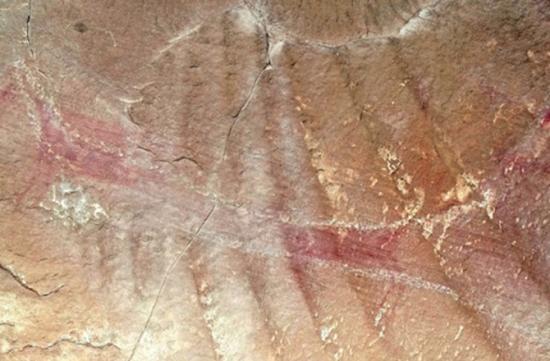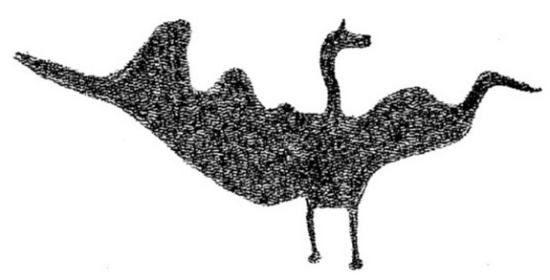Source - http://news.discovery.com/history/archaeology/winged-monster-rock-art-finally-deciphered-150819.htm
 A close-up view of the other "wing." Notice the white chalk lines that were added in the 1940s, and may have been re-chalked since then. JEAN-LOÏC LE QUELLEC, PAUL BAHN AND MARVIN ROWE, "THE DEATH OF A PTERODACTYL," ANTIQUITY, VOLUME 89, P 872-884, 2015, COPYRIGHT ANTIQUITY PUBLICATIONS LTD., PUBLISHED BY CAMBRIDGE UNIVERSITY PRESS, REPRODUCED WITH PERMISSION
A close-up view of the other "wing." Notice the white chalk lines that were added in the 1940s, and may have been re-chalked since then. JEAN-LOÏC LE QUELLEC, PAUL BAHN AND MARVIN ROWE, "THE DEATH OF A PTERODACTYL," ANTIQUITY, VOLUME 89, P 872-884, 2015, COPYRIGHT ANTIQUITY PUBLICATIONS LTD., PUBLISHED BY CAMBRIDGE UNIVERSITY PRESS, REPRODUCED WITH PERMISSION
The mystery surrounding the ancient rock paintings of Utah’s Black Dragon Canyon has finally been solved. For decades, researchers and creationists have debated whether the vibrant red pictographs are images of humans and animals, or rather, depictions of a large winged monster, possibly a pterosaur.
 Now, using cutting-edge technology, researchers suggest the red paintings show five separate images, including a tall bug-eyed person, a smaller person, a sheep, a dog and a serpentlike figure.
Now, using cutting-edge technology, researchers suggest the red paintings show five separate images, including a tall bug-eyed person, a smaller person, a sheep, a dog and a serpentlike figure.
“It is not a single figure. It is not a pterodactyl,” said co-lead researcher Paul Bahn, a freelance archaeologist. “It’s a beautiful set of images.”
The rock paintings belong to the agrarian Fremont culture (circa A.D. 1 to 1100). Other Fremont rock paintings — known as Barrier Canyon style — show abstract humanlike figures with elongated bodies and round heads, the researchers wrote in the study. These long figures are usually accompanied by tiny “attendants,” including people, birds and four-legged creatures, such as hoofed animals, canines, felines, badgers and bears.
Amateurs discovered the painting in 1928, and soon after talk of the “winged monster” arose. In 1947, a man named John Simonson traced over the paintings with chalk and said the end result looked like “a weird bird.”
Chalking rock art was a common practice in earlier years — ancient rock art is usually faint, and chalk can help make it visible — but today it’s illegal, Bahn said.
“It’s one of the worst things you can do, because it damages the art, it imposes what you think you can see on it, it messes up the chemistry of the rock, probably, and it just doesn’t disappear,” Bahn told Live Science.
Intriguing interpretations
The chalking may have influenced subsequent viewings of the art. Rock-art specialist Polly Schaafsma said she saw a “beak lined with sharp teeth” in a 1970 report. In 1979, geologist Francis Barnes said it looked “very much like a pterosaur, a Cretaceous flying reptile.”
The fossils of pterosaurs, flying reptiles that lived from 228 million to 66 million years ago, are found in the region. Some creationists began saying that the painting was a real-life impression of pterosaurs that lived at the same time as humans, and a few people even tried to identify the species, saying it was Quetzalcoatlus northropi, a reptile with a wingspan of about 39 feet (12 meters), Bahn said. (Many creationists believe the Earth is just several thousand years old, instead of about 4.5 billion years old, and as such humans and dinosaurs would have lived together.)
But to many researchers, the painted area clearly shows separate images, not a single image of a pterosaur.
“I myself visited the site in person a few years ago,” said Phil Senter, an associate professor of biology at Fayetteville State University in North Carolina, who was not associated with the study. “There’s no pterodactyl there at all. It’s a collection of other images.”
Benjamin Smith, a professor of world rock art at the University of Western Australia, stressed that humans knew little about dinosaurs and other extinct animals until the 1800s, long after the Fremont culture people painted Black Dragon Canyon.
“Since Native American art is of spiritual significance and holds significant religious content, images can also depict magical and mythical subject matter,” said Smith, who was not involved with the study. “Not all animals in Native American art therefore need to depict real-world creatures. Some will be supernatural, but none will be dinosaurs.”
Novel techniques
Bahn and his colleague Jean-Loi?c Le Quellec, a rock-art expert at the French National Centre for Scientific Research, traveled to Black Rock Canyon for their new TV documentary series, “On the Rocks,” in which they feature rock art from around the world.
Other experts have written studies that attempt to debunk the creationist pterosaur interpretation, but the new study is the first to use cutting-edge techniques, including a tool called DStretch and a portable X-ray fluorescence device, Bahn said.
[See Photos of the Rock Paintings from Black Dragon Canyon]